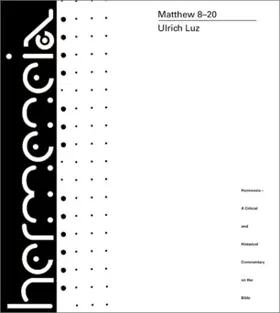

Matthew 2: 8–20
in Hermeneia
Pages
646
Publisher
Fortress Press
Published
1/26/2001
ISBN-13
9780800660345
Reviews
Matthew 8 8– –2 20 0 :: A A C Co om mm me en n tt a ar ry yTranslated by James E. CrouchHermeneia: A Critical and Historical Commentary onthe BibleMinneapolis: Fortress, 2001. Pp. xxxvii + 605. Cloth.$69.00. ISBN 080066034X.Dale C. Allison Jr.Pittsburgh Theological SeminaryPittsburgh, PA 15206The first installment of Ulrich Luz’s monumental four-volume commentary on Matthewfor the EKK series appeared in 1985. The final volume has just appeared in 2002. In 1989Augsburg published Wilhelm C. Linss’s English translation of the first volume, whichcovers Matt 1–7. Now James E. Crouch has translated for Fortress Press Luz’s secondvolume (which in German covers Matt 8–17) and part of his third (which covers Matt18–25), and the commentary has now found its way into the Hermeneia series of FortressPress. The preface to this second English volume informs readers that the remaining partof Luz’s third German volume as well as the fourth will be printed as the third Englishvolume, after which the first English volume will be reprinted in a revised edition withindices for the whole work. Presumably the revision of volume 1 will put the text into theHermeneia format and so make all three volumes consistent.The commentary proceeds pericope by pericope. Each section opens with a citation ofsecondary literature (no attempt is made to be exhaustive) and then a translation. The so-called “Analysis” follows. This consists of observations on the structure of each relevantpassage, conclusions about its sources, and, sometimes, suggestions regarding its origins.(Regarding this last subject, Luz believes that “at the center of Jesus’ proclamation” isdivine judgment and that this focus on judgment keeps his message “from becoming amessage of harmless love” [154]; sayings that forcefully proclaim eschatologicaljudgment, such as 10:32–33 and 11:21–22, are authentic; Luz even considers thepossibility that 10:23 comes from Jesus, and he offers an interpretation that does not “inprinciple” differ from that of Albert Schweitzer [91].) Then follows the interpretationproper, usually verse by verse.
[Full Review]
